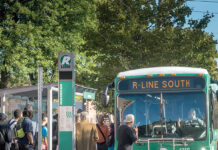An extra 6 cents doesn’t seem like much of a financial incentive, but state officials and environmental groups are hoping it’s enough to lure solar developers to a new type of project: solar canopies built over parking lots.
The R.I. Office of Energy Resources and its Distributed Generation Board is recommending adding a 6-cent-per-kilowatt-hour incentive for these solar carport projects on top of the fixed price paid for power generation.
For a solar carport producing 1.3 million kilowatt-hours per year, that would mean roughly $78,000 more annually, according to National Grid Rhode Island calculations.
Part of the intent is to dissuade developers from clear-cutting forests and using farmland to install large-scale solar arrays, which environmentalists and rural residents argue defeats the purpose of green energy.
A similar proposal for incentivizing lower-impact solar canopies over parking lots was rejected by the R.I. Public Utilities Commission last year, but it’s back on the agenda. A public hearing is scheduled for Feb. 4, and a decision is expected later in the month. If approved, the 6-cent “adder” would be included in the state’s 2020 Renewable Energy Growth Program, which under National Grid’s administration allows customers to sell their renewable energy output under long-term tariffs at fixed prices.
The PUC rejected the incentive last year for technical reasons, but supporters are hopeful the latest iteration adding solar carports as an extension of commercial solar arrays rather than a separate category will win approval, catalyzing a new direction for the burgeoning solar industry.
The Office of Energy Resources is working on a variety of programs and studies to entice developers toward already developed land, including brownfields and parking lots. Last year, the department rolled out $1 million in state funding through its Commercial Scale Renewable Energy Fund for brownfield solar projects and another $1 million for solar carports. Since June, the department has received numerous applications for brownfield projects, but none for carports, said Christopher Kearns, OER’s interdepartmental manager.
To date, only three solar carport projects have been built, producing less than 1% of the state’s solar output, Kearns said.
In a letter of support for the recommendation, the Northeast Clean Energy Council pointed to the success of a similar program in Massachusetts. The NCEC also noted that solar carports are more expensive to build because they require more steel structuring than other solar projects, making a financial incentive crucial.
“Providing an additional incentive for solar parking canopies indicates Rhode Island supports a broad set of solar solutions and will help the solar industry and their customers overcome the additional labor and material costs,” the council said.
The PUC also received letters of support from the Rhode Island League of Cities & Towns and one jointly from Grow Smart Rhode Island, the Audubon Society of Rhode Island, The Nature Conservancy and Save The Bay Inc.
Solar carports are a niche market, Kearns acknowledged. However, he also sees growth potential.
“It took several years to get where we are. With consistent programs and policies supporting parking lot locations, I expect we’ll also see the market grow,” he said.
Nancy Lavin is a PBN staff writer. Contact her at Lavin@PBN.com.











